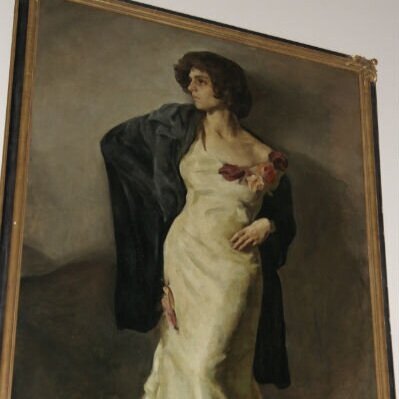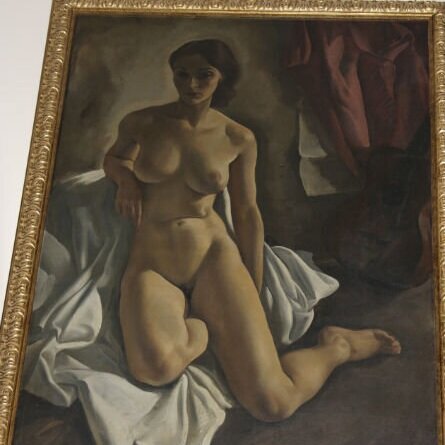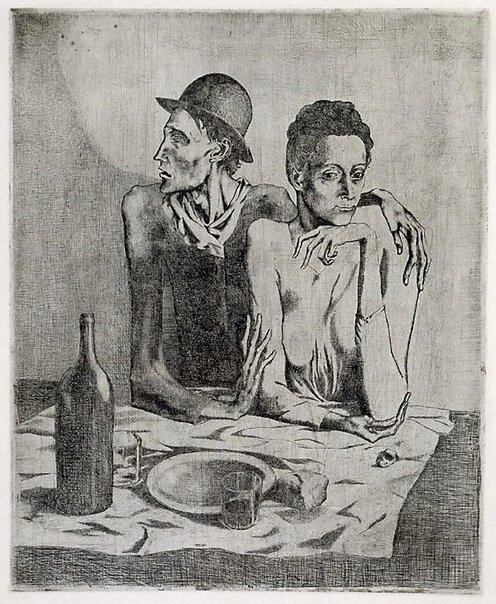Ep. 3-Artist on the Edge: The Early Years
In 1907 two baby girls were born in two culturally distinct countries—the United States and Mexico. Annette Margolis and Frida Kahlo would grow up to be accomplished artists, friends, and an integral part of a social circle of intensely creative people in Mexico City during its golden age of muralism.
A young Annette
Each of these women would freely follow their passions when it came to art, men, and life. Frida would become famous beyond her wildest imaginings, mostly after her death. Annette, although equally talented and creative, would remain in the shadows at the edge of the spotlight.
Annette and her two siblings, Miriam and Bernard, led a comfortable life with their parents, Samuel and Cecelia Margolis in New York City. The three children were delivered to Hunter Model School each day in a chauffeur-driven Marmon, wore fur muffs and hats in winter, and their parents regularly entertained other intellectuals at social gatherings in their home.
Surrounded by such luminaries as George G. Nathan, American editor and drama critic; Oswald Garrison Villard, the editor of The Nation; H. L. Mencken; and Sinclair Lewis, a life of art and ideas resonated early on for Annette. Her father, a modernist, believed girls should be equally as well-educated as boys, and she had the freedom to read anything she wished from their extensive family library. At the age of 12 her father took her to hear Clarence Darrow and Scott Nearing speculate about the existence of God.
A talented artist, creative and original at an early age, Annette attended Hunter High School and then Hunter College as an art major. At Hunter College she made her own clothes from unusual fabrics at the time, such as corduroy, and designed A-line skirts and boat neck tops form-fitted at the waist. Instinctively she knew what flattered her figure and enjoyed combining unconventional colors like turquoise, shocking pink, chartreuse, purples, yellows, oranges, honey tones and browns. She created unblocked velour and felt hats decorated with strings of colored beads, some of bone or shell.
In her own words, her signature auburn hair was “very curly and worn up, like a Medusa. One of my friends said I combed it with an eggbeater.”
Annette constantly painted and sketched. A nude portrait by her of a black girl, showing pubic hair, was selected for the yearbook but created a scandal. Subsequently the page was removed. During this time she won a scholarship to New York’s National Academy of Design and Composition.
Annette had a natural eye for fine art and, at the age of sixteen, made her first purchase from the historic Weyhe Gallery on Lexington: one of a run of 250 prints of Picasso’s The Frugal Repast (see below). She played the violin and had a debut at Carnegie Hall, but then gave up music and devoted herself to painting. Precocious in all ways, by age 18 Annette had secretly married Sidney Pepper, her first husband.
Pepper, a child prodigy who entered Columbia at sixteen and then went on to law school at New York University, was by the age of twenty-one or twenty-two already established at the firm of Dewitt, Pepper, and Howell in Manhattan. For a young woman used to being loved and protected, the attention Sidney showered on Annette must have been reassuring. He seemed so devoted, expressed that he adored her. Whatever she did was wonderful to him. He wasn’t the handsomest man around, or the most glamorous—but he must have been dazzled that this petite, curvaceous, red-haired beauty with so much enthusiasm for life could possibly be his wife. But marriage changed the direction of Annette’s life and her studies in art. She would not go back to college for the next year as she tried to become “a married lady.”
Within a shockingly short time, Annette’s beloved father died of a heart attack and, within six months, her mother died of cancer. Annette’s life had turned upside down. She was married and both her parents were dead. She had married when so many of her dreams were unfulfilled and, like many young women, when her idea of married life focused on the romantic rather than the reality of the responsibilities and restrictions it would bring.
There is early evidence that Annette and Sidney were not compatible. As his career advanced, her life became more and more circumscribed. He became something of a “despot,” in Annette’s words, demanding to know how she spent her time and where she was every minute. As she came to know him in daily life, Annette found Sidney boringly conservative, unreasonably possessive, and uncomfortable with her preference for bold colors and edgy fashion choices. The days seemed to stretch like a featureless desert before her.
Opportunity for adventure and excitement might have been limited, but Annette quickly found ways to circumvent the constraints of life with Pepper. The young couple had an apartment on Riverside Drive in Manhattan and, about a year after their marriage, Annette decided to go back to school to get a master’s in fine arts. Columbia was nearby and she had been awarded a scholarship at the National Academy.
She also made the daring decision to take some of that money and rent a small apartment under an assumed name on Barrow Street. Sidney did not know about it; it was a “very private secret.” Annette says, “I felt no guilt. I felt absolutely delightful about it! Annette would paint in her secret apartment and pose as a model for such upcoming artists as Russian painter Igor Pantuhoff and Sandor Klein. The two men would complete beautiful, full-sized portraits of her, one naked and one clothed (see below), and both would become her lovers. Annette’s longing for beauty, love, and a broader life was subverting her calm, upper middle-class life. Politics and art would soon light the fuse that would catapult her onto a completely different path.
NOTE: Photos of the portraits by Klein and Pantuhoff, mentioned above, were taken by me from a difficult angle, shooting up to where they were very highly placed on a wall. Not the best, but you can still see what lovely paintings they are and what a lovely young woman Annette was in this period.




